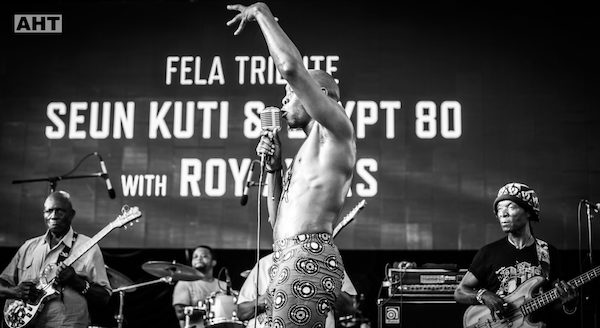Oct 28, 2025 10:47 AM
In Memoriam: Jack DeJohnette, 1942–2025
Jack DeJohnette, a bold and resourceful drummer and NEA Jazz Master who forged a unique vocabulary on the kit over his…

Seun Kuti (foreground) performs during the Paris New York Heritage Festival in Manhattan on July 16.
(Photo: Adrien H. Tillmann/facebook.com/parisnyfestival)Was the decision to sandwich vibraphonist Roy Ayers in between two sprawling Afrobeat bands a savvy piece of jazz advocacy, or just luck of the draw? Putting Brooklyn’s Underground System back-to-back with Seun Kuti & Egypt 80 on a Paris-New York Heritage Festival triple bill on July 16 in Manhattan’s Central Park would have saved the stage crew a long game of musical chairs—and validated a decades-old, Nigerian dance party tradition. On the other hand, it was encouraging to see Ayers get the chance to connect with a crowd of young listeners who might not know his work, even if that meant a lot of diehard fans, who had expected him to headline as originally advertised, ended up missing his set.
These days, Ayers plays the malletKAT Pro, an electronic vibraphone which can be a dead ringer for the acoustic instrument. Early in the set, it wasn’t: Technical glitches kept his whirling mallets out of the mix for a few minutes. Leading a quartet with Fender Rhodes, Fender bass and drums, Ayers went for double the nocturnal glimmer and ripple that has been his trademark throughout parts of seven decades.
They had time for just three 15-minute jams on the hits “Red, Gold And Green,” “Everybody Loves The Sunshine” and “Searchin’.” The idiom was pure 1980s, although the rhythm section was far more terse and purposeful than typically found in that era’s fusion. Ayers’ elegantly bluesy triplets, rapid-fire chromatic lines and judicious against-the-beat metrics reflected an earlier era, when he’d been a protégé of Lionel Hampton and mentored by Bobby Hutcherson. Meanwhile, his group kept a tight focus, save for a couple of warpy keytar interludes and a snazzy behind-the-back drum solo that ended with an over-the-shoulder flip of the sticks.
Ayers saved his most energetic, explosive volleys for a cameo with Kuti and his brassy, percussion-heavy 14-piece ensemble. The son and principal heir to Afrobeat pioneer Fela Kuti’s legacy has his father’s firebrand political sensibility, even if he hasn’t had to cope with the brutal repression of 1970s Lagos. Railing against the hypocrisy of “conscious capitalism” and noting that the peddling of half-truths from the executive branch has been de rigeur in Nigeria longer than it has been here, he took a brief turn on electric piano before displaying a bright, metallic Jackie McLean-like tone and fondness for allusive modes on alto sax.
He and the group opened with Fela’s abrasive 1975 condemnation of conspicuous consumption, “Expensive Shit.” In the 10 minutes it took to simmer and bubble to the conclusion, Kuti probably spat that four-letter word more times than any other act at this venue in the past several years. The rest of the set ran the gamut from a defiant pro-ganja anthem to “African Dreams,” a hypnotically undulating broadside against western cultural imperialism and how generations of young Africans have been seduced.
Bounding and strutting across the stage with an earthy gusto, singer-flutist Domenica Fossati—a charismatic whirlwind of Italian and African-American ancestry—led hometown crew Underground System through the afternoon’s longest and arguably most dynamic set, mixing up original Afrobeat with a more straight-up funk tune and a passionate Italian women’s rights anthem. Guitarist Peter Matson’s occasional departures into enigmatic noise and jagged funk were counterbalanced by keyboardist/organist Colin Brown’s keening whir over a slinky backdrop. The high point was the brassy “Rent Party,” something Fossati said the band knew a little something about.
Many faces in the crowd went west to Pier One on the Hudson for an afterparty, where Innov Gnawa—a traditional Moroccan trance-dance band—kept the crowd on their feet throughout a couple of otherworldly sets. Bandleader Hassan Ben Jaafar and his protégé, Samir LanGus, took turns playing hypnotic, artfully polyrhythmic riffs on three-string sintir bass-lute as the choir, singing in Arabic and clanking their cast-iron castanets, provided waves of call-and-response on ancient sub-Saharan, pre-Muslim animist themes.
As the night went on, Ben Jaafar subtly introduced a series of suspenseful chromatics, hinting at more Egyptian and Middle Eastern-flavored hmadcha modes. Eventually, percussionist Amino Belyamani sauntered into the dancing melee to teach them some moves. Fresh off an appearance at Coachella, this band is on the rise: Their agenda is to do for gnawa what Bob Marley did for reggae … or what Ayers did as an avatar of psychedelic, cinematic funk in the 1970s. DB

Jack DeJohnette boasted a musical resume that was as long as it was fearsome.
Oct 28, 2025 10:47 AM
Jack DeJohnette, a bold and resourceful drummer and NEA Jazz Master who forged a unique vocabulary on the kit over his…

Always a sharp dresser, Farnsworth wears a pocket square given to him by trumpeter Art Farmer. “You need to look good if you want to hang around me,” Farmer told him.
Sep 23, 2025 11:12 AM
When he was 12 years old, the hard-swinging veteran drummer Joe Farnsworth had a fateful encounter with his idol Max…

D’Angelo achieved commercial and critical success experimenting with a fusion of jazz, funk, soul, R&B and hip-hop.
Oct 14, 2025 1:47 PM
D’Angelo, a Grammy-winning R&B and neo-soul singer, guitarist and pianist who exerted a profound influence on 21st…

Kandace Springs channeled Shirley Horn’s deliberate phrasing and sublime self-accompaniment during her set at this year’s Pittsburgh International Jazz Festival.
Sep 30, 2025 12:28 PM
Janis Burley, the Pittsburgh International Jazz Festival’s founder and artistic director, did not, as might be…

Jim McNeely’s singular body of work had a profound and lasting influence on many of today’s top jazz composers in the U.S. and in Europe.
Oct 7, 2025 3:40 PM
Pianist Jim McNeely, one of the most distinguished large ensemble jazz composers of his generation, died Sept. 26 at…